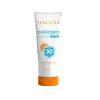What's inside
What's inside
 Key Ingredients
Key Ingredients

 Benefits
Benefits

 Concerns
Concerns

 Ingredients Side-by-side
Ingredients Side-by-side

Water
Skin ConditioningEthylhexyl Methoxycinnamate
UV AbsorberAlcohol Denat.
AntimicrobialDiethylamino Hydroxybenzoyl Hexyl Benzoate
UV FilterDimethicone
EmollientArachidyl Alcohol
EmollientGlycerin
HumectantPhenoxyethanol
PreservativeTriethanolamine
BufferingBehenyl Alcohol
EmollientAloe Barbadensis Leaf Extract
EmollientPanthenol
Skin ConditioningAcrylates/C10-30 Alkyl Acrylate Crosspolymer
Emulsion StabilisingArachidyl Glucoside
EmulsifyingPropylene Glycol
HumectantPropanediol
SolventParfum
MaskingAllantoin
Skin ConditioningBHT
AntioxidantXanthan Gum
EmulsifyingDisodium EDTA
Hydrolyzed Wheat Protein/Pvp Crosspolymer
Ethylhexylglycerin
Skin ConditioningPotassium Sorbate
PreservativeArtemisia Capillaris Flower Extract
Skin ConditioningSodium Benzoate
MaskingWater, Ethylhexyl Methoxycinnamate, Alcohol Denat., Diethylamino Hydroxybenzoyl Hexyl Benzoate, Dimethicone, Arachidyl Alcohol, Glycerin, Phenoxyethanol, Triethanolamine, Behenyl Alcohol, Aloe Barbadensis Leaf Extract, Panthenol, Acrylates/C10-30 Alkyl Acrylate Crosspolymer, Arachidyl Glucoside, Propylene Glycol, Propanediol, Parfum, Allantoin, BHT, Xanthan Gum, Disodium EDTA, Hydrolyzed Wheat Protein/Pvp Crosspolymer, Ethylhexylglycerin, Potassium Sorbate, Artemisia Capillaris Flower Extract, Sodium Benzoate
Water
Skin ConditioningEthylhexyl Methoxycinnamate
UV AbsorberDiethylamino Hydroxybenzoyl Hexyl Benzoate
UV FilterNeopentyl Glycol Diheptanoate
EmollientButylene Glycol
HumectantEthylhexyl Triazone
UV AbsorberTris-Biphenyl Triazine
UV AbsorberButyl Methoxydibenzoylmethane
UV AbsorberNiacinamide
SmoothingBis-Ethylhexyloxyphenol Methoxyphenyl Triazine
Skin ConditioningButyloctyl Salicylate
Skin ConditioningInositol
HumectantOctocrylene
UV AbsorberGlycine Soja Oil
EmollientPhenoxyethanol
PreservativePolyester-7
Skin ConditioningAcrylates/C10-30 Alkyl Acrylate Crosspolymer
Emulsion StabilisingDecyl Glucoside
CleansingCarbomer
Emulsion StabilisingDisodium EDTA
Polyglyceryl-3 Diisostearate
EmulsifyingSodium Polyacrylate
AbsorbentHydrogenated Polydecene
EmollientLactobacillus/Collagen Ferment Filtrate
HumectantLecithin
EmollientOryza Sativa Germ Extract
EmollientSodium Hydroxide
BufferingTocopheryl Acetate
AntioxidantTriethylene Glycol
MaskingDisodium Phosphate
BufferingTrideceth-6
EmulsifyingXanthan Gum
EmulsifyingArtemisia Vulgaris Extract
Skin ConditioningWater, Ethylhexyl Methoxycinnamate, Diethylamino Hydroxybenzoyl Hexyl Benzoate, Neopentyl Glycol Diheptanoate, Butylene Glycol, Ethylhexyl Triazone, Tris-Biphenyl Triazine, Butyl Methoxydibenzoylmethane, Niacinamide, Bis-Ethylhexyloxyphenol Methoxyphenyl Triazine, Butyloctyl Salicylate, Inositol, Octocrylene, Glycine Soja Oil, Phenoxyethanol, Polyester-7, Acrylates/C10-30 Alkyl Acrylate Crosspolymer, Decyl Glucoside, Carbomer, Disodium EDTA, Polyglyceryl-3 Diisostearate, Sodium Polyacrylate, Hydrogenated Polydecene, Lactobacillus/Collagen Ferment Filtrate, Lecithin, Oryza Sativa Germ Extract, Sodium Hydroxide, Tocopheryl Acetate, Triethylene Glycol, Disodium Phosphate, Trideceth-6, Xanthan Gum, Artemisia Vulgaris Extract
Ingredients Explained
These ingredients are found in both products.
Ingredients higher up in an ingredient list are typically present in a larger amount.
Acrylates/C10-30 Alkyl Acrylate Crosspolymer is a synthetic polymer. It is used to thicken and improve the texture of products. Due to its properties, it can prevent water and oil ingredients from separating.
Diethylamino Hydroxybenzoyl Hexyl Benzoate (DHHB) is a chemical UV-A absorber. It is formulated for high UVA protection (320-400 nm).
DHHB is well-liked for:
DHHB has been approved by the EU, Japan, Taiwan, and South America for use up to 10%. Unfortunately, it has not been approved for use in the US or Canada due to slow regulatory processes.
This ingredient is soluble in oils, fats, and lipids.
Learn more about Diethylamino Hydroxybenzoyl Hexyl BenzoateDisodium EDTA plays a role in making products more stable by aiding other preservatives.
It is a chelating agent, meaning it neutralizes metal ions that may be found in a product.
Disodium EDTA is a salt of edetic acid and is found to be safe in cosmetic ingredients.
Learn more about Disodium EDTAEthylhexyl Methoxycinnamate is an organic compound that provides UVB protection. It often goes by the more common name of octinoxate. It is created from methoxycinnamic acid and 2-ethylhexanol.
Ethylhexyl Methoxycinnamate absorbs UVB rays with wavelengths between 280-320 nm. UV absorbers protect your skin by using chemical reactions to convert UV rays into heat and energy.
UVB (290-320 nm) rays emit more energy than UVA rays. They are capable of damaging DNA, causing sunburns and are thought to be linked to skin cancer.
The state of Hawaii has banned sunscreens containing octinoxate due to its potential impact on coral reefs. More research is needed to bridge gaps in this research. The European Union allows higher levels of octinoxate in sunscreens than the US and Australia.
Ethylhexyl Methoxycinnamate is oil soluble. It is not stable and may lose efficacy when exposed to sunlight.
Learn more about Ethylhexyl MethoxycinnamatePhenoxyethanol is a preservative that has germicide, antimicrobial, and aromatic properties. Studies show that phenoxyethanol can prevent microbial growth. By itself, it has a scent that is similar to that of a rose.
It's often used in formulations along with Caprylyl Glycol to preserve the shelf life of products.
Water. It's the most common cosmetic ingredient of all. You'll usually see it at the top of ingredient lists, meaning that it makes up the largest part of the product.
So why is it so popular? Water most often acts as a solvent - this means that it helps dissolve other ingredients into the formulation.
You'll also recognize water as that liquid we all need to stay alive. If you see this, drink a glass of water. Stay hydrated!
Learn more about WaterXanthan gum is used as a stabilizer and thickener within cosmetic products. It helps give products a sticky, thick feeling - preventing them from being too runny.
On the technical side of things, xanthan gum is a polysaccharide - a combination consisting of multiple sugar molecules bonded together.
Xanthan gum is a pretty common and great ingredient. It is a natural, non-toxic, non-irritating ingredient that is also commonly used in food products.
Learn more about Xanthan Gum